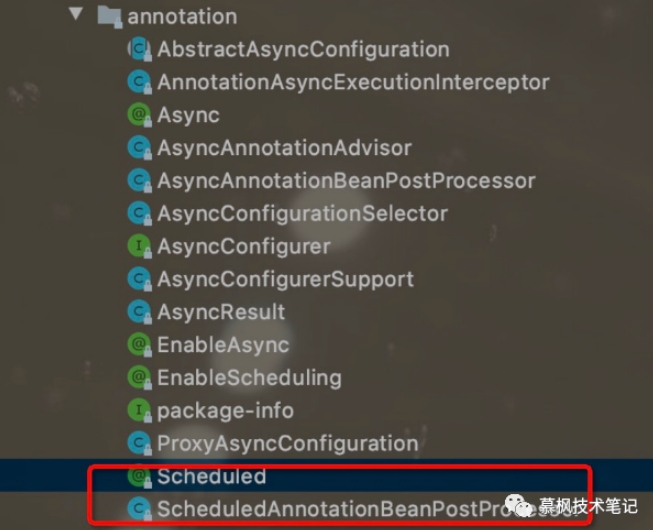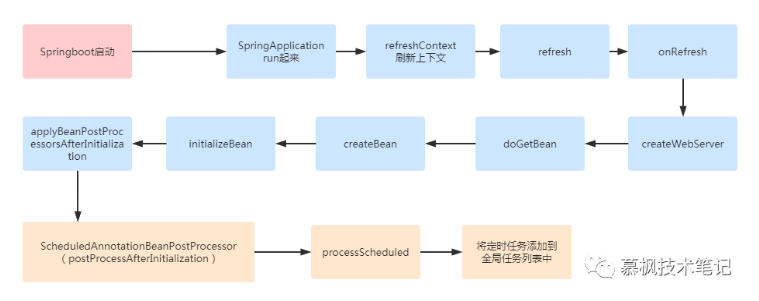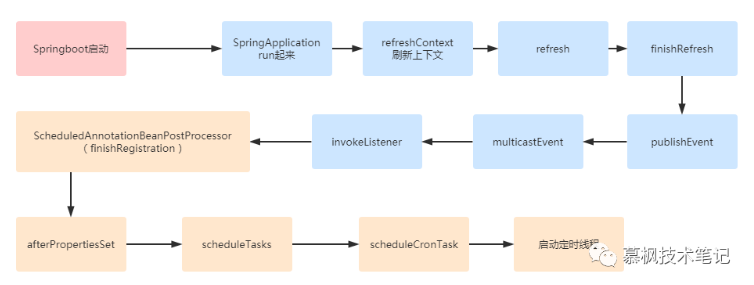问题背景
在一些业务场景中,我们需要执行定时操作来完成一些周期性的任务,比如每隔一周删除一周前的某些历史数据以及定时进行某项检测任务等等。在日常开发中比较简单的实现方式就是使用Spring的@Scheduled(具体使用方法不再赘述)注解。但是这个Spring框架自带的注解其实是有坑的。在修改服务器时间时会导致定时任务不执行情况的发生,粗暴解决办法是当修改服务器时间后,将服务进行重启就可以避免此现象的发生。本文将主要探讨服务器时间修改导致@Scheduled注解失效的原因,同时找到在修改服务器时间后不重启服务的情况下,定时任务仍然正常执行的方法。
@Scheduled 失效原因分析
在分析@Scheduled失效的原因之前,我们得先搞清楚它到底是怎样运行的,才能抽丝剥茧找到真正的根本原因。在SpringBoot启动之后,关于@Scheduled部分主要做了两件事情,一个是扫描所有@Scheduled注解修饰的方法,将对应的定时任务加到全局的任务队列中。另一个是启动定时任务线程池,开始时间计算与周期的定时任务。
1、@Scheduled 解析
首先看下Spring是如何解析@Scheduled注解的。这里说下看源码的一个小技巧,一般情况下,注解以及注解的解析类都在一个包下面,如下所示:
由上图可知,ScheduledAnnotationBeanPostProcessor便是解析@Scheduled注解的类。我们都知道以BeanPostProcessor结尾的类都是对于Spring框架能力的一种扩展方式,在bean初始化阶段分别调用其实现的before以及after方法,对bean能力进行增强。Spring框架会将所有的BeanPostProcessor,对其中涉及到的前后增强方法进行调用。postProcessAfterInitialization便是在bean初始化之后进行调用。下图所示为SpringBoot启动后,ScheduledAnnotationBeanPostProcessor调用的大致流程。
ScheduledAnnotationBeanPostProcessor对应的源码如下所示:
public class ScheduledAnnotationBeanPostProcessor implements MergedBeanDefinitionPostProcessor, DestructionAwareBeanPostProcessor, Ordered, EmbeddedValueResolverAware, BeanNameAware, BeanFactoryAware, ApplicationContextAware, SmartInitializingSingleton, ApplicationListener<ContextRefreshedEvent>, DisposableBean {
...public Object postProcessAfterInitialization(Object bean, String beanName) { if (bean instanceof AopInfrastructureBean) { return bean; } else { //(key-1)解析所有Scheduled注解的类 Class<?> targetClass = AopProxyUtils.ultimateTargetClass(bean); if (!this.nonAnnotatedClasses.contains(targetClass)) { Map<Method, Set<Scheduled>> annotatedMethods = MethodIntrospector.selectMethods(targetClass, new MetadataLookup<Set<Scheduled>>() { public Set<Scheduled> inspect(Method method) { Set<Scheduled> scheduledMethods = AnnotatedElementUtils.getMergedRepeatableAnnotations(method, Scheduled.class, Schedules.class); return !scheduledMethods.isEmpty() ? scheduledMethods : null; } }); if (annotatedMethods.isEmpty()) { this.nonAnnotatedClasses.add(targetClass); if (this.logger.isTraceEnabled()) { this.logger.trace("No @Scheduled annotations found on bean class: " + targetClass); } } else { Iterator var5 = annotatedMethods.entrySet().iterator();
while(var5.hasNext()) { Entry<Method, Set<Scheduled>> entry = (Entry)var5.next(); Method method = (Method)entry.getKey(); Iterator var8 = ((Set)entry.getValue()).iterator();
while(var8.hasNext()) { Scheduled scheduled = (Scheduled)var8.next(); //(key-2)处理被注解修饰的类 this.processScheduled(scheduled, method, bean); } }
if (this.logger.isDebugEnabled()) { this.logger.debug(annotatedMethods.size() + " @Scheduled methods processed on bean '" + beanName + "': " + annotatedMethods); } } }
return bean; } }
...
}
复制代码
它主要做了两件事情:
key-1:
解析所有以@Scheduled以及@Schedules注解修饰的方法,将方法以及对应的注解集合存入一个map中,这里注意方法作为key对应的 value 是一个集合,说明一个方法可以被多个@Scheduled以及@Schedules进行修饰。
key-2:
将key-1``map的方法取出后进行处理,即调用processScheduled方法。如下所示:
protected void processScheduled(Scheduled scheduled, Method method, Object bean) { try { Runnable runnable = this.createRunnable(bean, method); boolean processedSchedule = false; String errorMessage = "Exactly one of the 'cron', 'fixedDelay(String)', or 'fixedRate(String)' attributes is required"; Set<ScheduledTask> tasks = new LinkedHashSet(4); long initialDelay = scheduled.initialDelay(); ... //(key-1)获取注解中对应的scron参数 String cron = scheduled.cron(); if (StringUtils.hasText(cron)) { String zone = scheduled.zone(); if (this.embeddedValueResolver != null) { cron = this.embeddedValueResolver.resolveStringValue(cron); zone = this.embeddedValueResolver.resolveStringValue(zone); }
if (StringUtils.hasLength(cron)) { Assert.isTrue(initialDelay == -1L, "'initialDelay' not supported for cron triggers"); processedSchedule = true; if (!"-".equals(cron)) { TimeZone timeZone; if (StringUtils.hasText(zone)) { timeZone = StringUtils.parseTimeZoneString(zone); } else { timeZone = TimeZone.getDefault(); } //(key-2)添加到任务列表 tasks.add(this.registrar.scheduleCronTask(new CronTask(runnable, new CronTrigger(cron, timeZone)))); } } }
...
Assert.isTrue(processedSchedule, errorMessage); Map var18 = this.scheduledTasks; synchronized(this.scheduledTasks) { Set<ScheduledTask> regTasks = (Set)this.scheduledTasks.computeIfAbsent(bean, (key) -> { return new LinkedHashSet(4); }); regTasks.addAll(tasks); } } catch (IllegalArgumentException var25) { throw new IllegalStateException("Encountered invalid @Scheduled method '" + method.getName() + "': " + var25.getMessage()); } }
复制代码
说明:本文主要阐述 scron 定时任务解析。
key-1:
将注解中的时间参数进行获取与解析。
key-2:
将任务包装为CronTask添加到全局计划任务中。
2、定时任务启动
在springboot启动后,通过监听事件完成定时任务启动。
public ScheduledTask scheduleCronTask(CronTask task) { ScheduledTask scheduledTask = this.unresolvedTasks.remove(task); boolean newTask = false; if (scheduledTask == null) { scheduledTask = new ScheduledTask(); newTask = true; } if (this.taskScheduler != null) { scheduledTask.future = this.taskScheduler.schedule(task.getRunnable(), task.getTrigger()); } else { addCronTask(task); this.unresolvedTasks.put(task, scheduledTask); } return (newTask ? scheduledTask : null); }
复制代码
根本原因,JVM启动之后会记录系统时间,然后JVM根据CPU ticks自己来算时间,此时获取的是定时任务的基准时间。如果此时将系统时间进行了修改,当Spring将之前获取的基准时间与当下获取的系统时间进行比对时,就会造成Spring内部定时任务失效。因为此时系统时间发生变化了,不会触发定时任务。
public ScheduledFuture<?> schedule() { synchronized (this.triggerContextMonitor) { this.scheduledExecutionTime = this.trigger.nextExecutionTime(this.triggerContext); if (this.scheduledExecutionTime == null) { return null; } //获取时间差 long initialDelay = this.scheduledExecutionTime.getTime() - System.currentTimeMillis(); this.currentFuture = this.executor.schedule(this, initialDelay, TimeUnit.MILLISECONDS); return this; } }
复制代码
@Scheduled 失效问题解决
1、粗暴的解决办法
将服务进行重启,重启后的服务根据服务器调整过后的时间重新进行任务执行时间计算,就不会产生定时任务不执行的问题,但是该解决办法太不友好了。
2、优雅的解决办法
为了避免使用@Scheduled注解,在修改服务器时间导致定时任务不执行情况的发生。在项目中需要使用定时任务场景的情况下,使ScheduledThreadPoolExecutor进行替代,它任务的调度是基于相对时间的,原因是它在任务的内部 存储了该任务距离下次调度还需要的时间(使用的是基于 System.nanoTime实现的相对时间 ,不会因为系统时间改变而改变,如距离下次执行还有 10 秒,不会因为将系统时间调前 6 秒而变成 4 秒后执行)。















评论